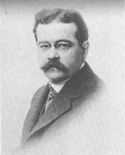Charles Fort
Charles Fort made a living studying strange occurrences which he then compiled in several books. Those not only sold well but remain in print today, giving Uncyclopedia's Unnews writers hope that they, too, can perhaps cash in on "lies, damned lies, and statistics," as Mark Twain defined fiction.
Early Daze[edit | edit source]
Fort was born (some say, hatched) in New York (some say, Albany), and claimed to have had Dutch (some say, German) parents (some say, rabbits). His father, he said, was cruel and abusive, making him wear wooden shoes. Although he was the oldest of his siblings, he was given the best name, his brothers being christened Clarence and Raymond. Although he had no degree in psychology, Fort's biographer, Damon Knight, took it upon himself to psychoanalyze his subject, availing himself of one of the few (some would say, the only) schools of thought concerning human behavior at the time, Sigmund Freud's psychoanalysis. According to Knight, Fort's rebelliousness against authority may have stemmed from the actions of his abusive father. The wearing of the wooden shoes, Knight contends, crippled Fort as much psychologically as it did physically, binding his mind as much as the shoes bound his feet.
Early in life, Fort displayed the three classic symptoms of serial killers: arson, animal abuse, and bedwetting. He once set fire to paper under a pile of kindling wood and logs in his father's fireplace, and he would collect live birds(Some would say they were dead). In addition, he wet his bed until he was 45 years of age, whereafter he began to wear a diaper and began to enjoy portraying an adult baby during sadomasochistic bondage and discipline games.
Having grown up in relative poverty, at the age of 18, he left his wooden shoes behind forever, packing his matches and his live birds (mostly wrens and robins), and ran away from home to "put some capital in the bank of experience," as he put it. During his travels, he became ill and was nursed by Anna Filing, a pretty girl who wore a size 38DD brassiere and produced ample nourishment for the ailing youth during their breastfeeding sessions. In appreciation, Fort proposed to her, and she accepted, providing wholesome, grade A breast milk for her loving husband ever thereafter.
Between bouts of depression and poverty, Fort occasionally managed to sell short a story, a poem, or an essay concerning arson, animal abuse, or bedwetting. Most of the time, however, the lovebirds were compelled to dine on Anna's pet parakeets.
Inheritance[edit | edit source]
In 1916, one of Fort's uncles died, leaving him a modest fortune. Fort bought several books on poisons, becoming quite an expert on the subject. A year later, his brother Clarence, who had seemingly been in the best of health, died suddenly. Clarence's portion of their uncle's bequest was divided between Charles and his sole surviving brother Raymond, who went on to star in the hit television situation comedy (sitcom), Everybody Loves Raymond, in 1956. It bears mentioning that Raymond was 91 years old at the time and only survived the first shoot.
Sex[edit | edit source]
Although Fort wrote 10 novels, he could find a publisher for only one, Sex Is Better With A Partner (1906), and his lack of success in his chosen field unhinged his mind. Despite paranoia, schizophrenia, and several other, lesser mental disorders and illnesses, Fort continued to write. He chose X and Y as the titles of his two latest books, dedicating them to the sex chromosomes. The would-be psychologist Knight theorizes in his highly fictionalized biography of Fort that the mentally ill writer might thus have attempted to remind the dozen or so people who had read Sex Is Better With A Partner that reading his books brought pleasure.
In X, he speculated that Martians controlled earthly events, especially the incidents and circumstances of his own life, including the writing of X. In Y, he offered the view that a mysterious and sinister race of beings with supernatural or paranormal powers, whom he called The Inhumans, lived at the South Pole. His notions caught the eye of another mentally disturbed author, Theodore Dreiser, who sought to find a publisher for Fort, but to no avail. In a childish tantrum, Fort burned the X and Y manuscripts.
Peculiarly, Marvel Comics later published several series of comics that featured The Inhumans, a mysterious and sinister race of beings with supernatural or paranormal powers, who lived at the South Pole, but the company's editor, Stan Lee, claimed that the parallels between the two sets of characters, their powers, and the comic book stories' setting were mere coincidences.
The Catalogue of the Damned[edit | edit source]
Between stints as a homeless person before marrying his nurse and inheriting his uncle, Fort had worked as a journalist, since this was a job that required no education, skill, talent, or sanity. His work in this field, Knight contends, helped him to succeed, finally, as a writer, when he actually found a publisher for his latest effort, The Book of the Damned. The "damned" were facts that didn't fit into the neat categories and theories of the all-knowing scientists of his day. These "facts," all of which Fort made up between naps in the public library, include:
- A rain of green toads
- Women called transsexuals, who had both breasts and male genitals
- Women called Amazons, who had but one breast (usually the right one)
- The existence of a good five-cent cigar
- Ships that flew through the sky, usually at night
- Cities that flew south for the winter
- Birds with scales and fish with wings
- Politicians who put the interests of their nation ahead of their own
The Book of the Damned was followed by several other equally preposterous tomes, full of "facts" that Fort invented, attributing them to imaginary sources:
- Wild Talents
- New Lands
- Lo!
- Many Parts
- Bah, Humbug!
Mandatory Wikipedia Reference[edit | edit source]
Wikipedia, in its tireless efforts to become omniscient, includes among its thousands and thousands of articles one on Fort, from which this excerpt, describing Fort’s writing style, is stolen:
- Understanding Fort's books takes time and effort: his style is complex, violent and poetic, satirical and subtle, profound and occasionally puzzling. Ideas are abandoned and then recalled a few pages on; examples and data are offered, compared and contrasted, conclusions made and broken, as Fort holds up the unorthodox to the scrutiny of the orthodoxy that continually fails to account for them. Pressing on his attacks, Fort shows the ridiculousness of the conventional explanations and then interjects with his own theories [1].
Sargasso Sea[edit | edit source]
Fort’s own theories are far more rational, plausible, and believable than those of the scientists whom he mocks, Knight suggests, citing Fort’s theory of the Sargasso Sea as an example. The Sargasso Sea encircles the earth, Fort says, and is a cosmic lost and found where all things that become missing are located, occasionally returning to the Earth via tornadoes. According to Fort, it was his theory of the Sargasso Sea that inspired Albert Einstein’s special theory of relativity, although, Fort contended, “there wasn’t anything ‘special’ about it.”
Skeptical Postulates and Boils[edit | edit source]
In his writings, Fort chastised scientists, identifying several postulates that skeptics (and all-too-often all-too-gullible scientists) should hold:
- What is impossible is unlikely, but what is likely may be impossible
- Facts are not opinions, but opinions can be facts.
- There is a strong schoolgirl influence as to what may be regarded as fashionable in scientific thought.
- Believing in something strongly enough may cause headaches
- It is better to keep one's mouth shut and be considered a fool than to open it and remove all doubt.
- I wish all the ladies were pies on the shelf, and I were the baker; I'd eat them all myself.
Knight cautions Fort's readers: "His views are interesting and unusual, but they are only as reliable as his sources,” to which Fort replied: “I offer the data. Suit yourself.”
Famous Forteans[edit | edit source]
Famous followers of Fort, or Forteans, as they call themselves, include:
- Ben Hecht
- Sherwood Anderson
- Clarence Darrow
- Booth Tarkington
- Charles Darwin
- Tom Cruise
- Sarah Michelle Gellar
- Lex Luthor.
Misquote[edit | edit source]
A quotation attributed to Fort is “Life is a tale told by an idiot, full of sound and fury signifying nothing.” However, this is a line from MacBeth, a play attributed to William Shakespeare. What Fort actually said is “If there is a universal mind, must it be sane?”


